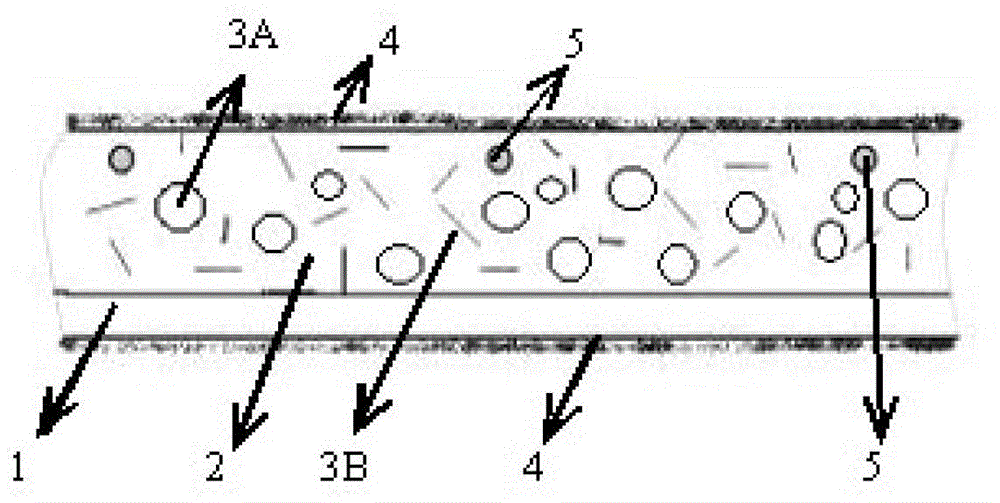Low-resistance and high-strength ion exchange membrane for chlor-alkali industry and preparation method of low-resistance and high-strength ion exchange membrane
A technology of ion exchange membrane and chlor-alkali industry, which is applied in the field of polymer materials, can solve the problems of membrane strength reduction and membrane mechanical strength reduction, and achieve the effects of reducing cell voltage, improving mechanical strength, and reducing transmission resistance
- Summary
- Abstract
- Description
- Claims
- Application Information
AI Technical Summary
Problems solved by technology
Method used
Image
Examples
Embodiment 1
[0042] The perfluorosulfonic acid resin in this example has an ion exchange capacity of 0.95 mmol / g, and is a powder obtained by copolymerization of tetrafluoroethylene and perfluoro 3,6-dioxa-4-methyl-7-octenesulfonyl fluoride body.
[0043] The perfluorocarboxylic acid resin in this example has an ion exchange capacity of 0.93 mmol / g, and is a powder obtained by copolymerization of tetrafluoroethylene and perfluoro 4,7-dioxa-5-methyl-8-nonenoic acid methyl ester.
[0044] (1) Preparation of resin pellets
[0045] Mix PET fibers with a diameter of 20±5 nanometers and a length of 10±2 microns with calcium carbonate with an average particle diameter of 25 nanometers at a mass ratio of 80:20 to obtain a mixed nano sacrificial material.
[0046] The mixed nano sacrificial material and the above-mentioned perfluorosulfonic acid resin powder are fully mixed according to the mass ratio of 4:100, and then melted, extruded and granulated to obtain perfluorosulfonic acid resin pellets...
Embodiment 2
[0055] Embodiment 2: The perfluorosulfonic acid resin and perfluorocarboxylic acid resin powders in this embodiment are the same as those in Embodiment 1.
[0056] (1) Preparation of resin pellets
[0057] The mixed nano sacrificial material is: a mixture of nylon 66 with a diameter of 20±5 nanometers and a length of 10±2 microns and calcium carbonate particles with an average particle diameter of 80 nanometers in a mass ratio of 30:70.
[0058] Fully mix the mixed nano sacrificial material with the above-mentioned perfluorosulfonic acid resin powder at a mass ratio of 10:100, then melt, extrude and granulate to obtain pellets of perfluorosulfonic acid resin containing nanofiber materials, perfluorocarboxylic acid resin powder The pellets of the perfluorocarboxylic acid resin are obtained through melt extrusion and granulation.
[0059] (2) Membrane preparation and reinforcement
[0060] Using the above-mentioned perfluorocarboxylic acid resin pellets and perfluorosulfonic a...
Embodiment 3
[0068] Step (1), step (2) and step (3) are the same as in Example 1, except that the PET fiber in step (1) has a diameter of 50±5 nanometers and a length of 20±2 micrometers.
[0069] The ion-exchange membrane prepared by the present embodiment has a tensile strength of 33MPa, and is used for the ion-exchange membrane in the chlor-alkali ion-exchange membrane electrolyzer at 4.5kA / m 2 Under the conditions of current density of 32% by mass ratio of cathode NaOH solution, 305g / L brine concentration of anode brine entering the tank, 210g / L NaCl concentration of brine leaving the tank, tank temperature of 85-87°C, active cathode, and 1mm pole distance Test, the cell voltage is 3.10-3.12V, and the cathode alkali current efficiency is 96.7%.
PUM
| Property | Measurement | Unit |
|---|---|---|
| thickness | aaaaa | aaaaa |
| thickness | aaaaa | aaaaa |
| length | aaaaa | aaaaa |
Abstract
Description
Claims
Application Information
 Login to View More
Login to View More - R&D
- Intellectual Property
- Life Sciences
- Materials
- Tech Scout
- Unparalleled Data Quality
- Higher Quality Content
- 60% Fewer Hallucinations
Browse by: Latest US Patents, China's latest patents, Technical Efficacy Thesaurus, Application Domain, Technology Topic, Popular Technical Reports.
© 2025 PatSnap. All rights reserved.Legal|Privacy policy|Modern Slavery Act Transparency Statement|Sitemap|About US| Contact US: help@patsnap.com

